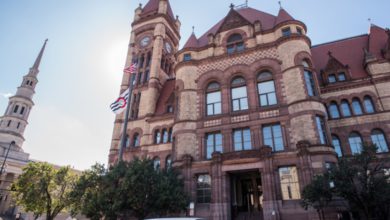Editor's note: Having trouble connecting? Read USA TODAY's text-only storm updates.
Fleets of boats, high-water vehicles and helicopters rescued hundreds trapped by Hurricane Ida’s floodwaters across southern Louisiana on Monday and utility repair crews rushed in to restore the power grid after the storm left a path of destruction on its way out the state.
More than 1 million homes and businesses were without power in Louisiana and another 90,000 in Mississippi as Ida, downgraded from a furious Category 4 hurricane to a tropical storm, remained a danger with its heavy rains and storm surge.
Two deaths have been confirmed -- a person hit by a falling tree outside Baton Rouge and later a male driver who drowned in New Orleans. The Louisiana Department of Health said the motorist drowned after trying to drive through floodwater.
A third person was attacked Monday by an alligator in flood waters caused by the storm near Slidell, located just across Lake Pontchartrain from New Orleans, according to Jason Gaubert, a spokesman for the St. Tammany Fire District No. 1.
The man's wife witnessed the attack, which took the man's arm off, Gaubert told USA TODAY. When his wife went to call for help, the man disappeared into the flood waters. His body hasn't been recovered and officials were investigating, Gaubert said.
Louisiana Gov. John Bel Edwards said he expected the death toll to rise "considerably.''
The governor’s office said damage to the power grid appeared “catastrophic” – dispiriting news for those without refrigeration or air conditioning amid the stifling heat and humidity. Forecasts call for temperatures in the mid-80s to near 90 by midweek.
"I can’t tell you when the power is going to be restored. I can’t tell you when all the debris is going to be cleaned up and repairs made,” Edwards said in a news conference. “But what I can tell you is we are going to work hard every day to deliver as much assistance as we can.”
Edwards said at least 671 people had been rescued by Monday afternoon.
Ida, which roared onto the Gulf Coast near Port Fourchon, Louisiana, on Sunday with 150-mph winds, knocked out power to the entire city of New Orleans before heading northeast toward Mississippi.
Levees failed or were overtopped along some rivers and bayous south of New Orleans but held up in the city. Some people posted their addresses and locations on social media to direct rescue teams. Roofs were torn off some buildings by the powerful winds, which decreased to about 35 mph by mid-afternoon. Still, tropical storm-force winds extended out 150 miles.
"Heavy rainfall and flash flooding threat continues to spread inland,'' the National Hurricane Center said in its 4 p.m. Central Time update, when Ida was 20 miles northwest of Jackson, Mississippi.
The storm was inching north at 9 mph, the slow roll driving up rainfall totals and toppling power lines along Ida's path.
At least 1 death in Louisiana as New Orleans loses power; Biden approves major disaster declaration
Heat, water contamination among top concerns in Ida's wake, ex-FEMA head says
Craig Fugate, the former head of FEMA under President Barack Obama, said with the threat of flooding diminishing as waters recede in Louisiana, the loss of electricity poses a serious danger to residents. Temperatures in New Orleans for the next two days are predicted to hit 88 degrees with high humidity -- conditions that can be dangerous for some without air conditioning, he said.
"We're still in summer and so without electricity, it's going to be very dangerous for the elderly, for those with pre-existing conditions, on top of dealing with COVID," Fugate said.
He said reports of the loss of water pressure in Jefferson Parish suggests downed trees have ripped open water and sewer lines, raising concerns about access to clean drinking water and sewage pollution.
"That will be driving a lot of FEMA response after the initial rescues," Fugate added.
Lines for gas at station damaged by storm
About 24 hours after Hurricane Ida made landfall in southeast Louisiana, lines of people waited Monday to fill cans with gas at a station and store called Veillon’s in Prairieville.
The building had sustained damage, with metal roofing peeled and lying twisted on the ground, and its doors and windows remained boarded. But the pumps were still working and accepting credit cards, and the word had gotten around Facebook, prompting Monday's lines.
People came with multiple cans to get fuel for their generators at home. The whole town seemed to be without electricity after the Category 4 storm hit the state. Prairieville seemed to miss the rain but not the strong winds.
Linemen working the area said they were addressing outages at hospitals, police stations and other emergency locations before they head into the community to restore power.
New Orleans' $14 billion risk-reduction system passes major test
The memories of endless miles of flooded streets still haunt some New Orleans residents who lived through the Hurricane Katrina disaster 16 years ago.
Though Hurricane Ida was technically stronger with winds of up to 150 mph -- making it a Category 4, one level higher than Katrina -- the frequent scenes of people getting rescued from the roof of their New Orleans homes as the floodwaters surged appear not to have been replicated this time.
That's because the levee system for the most part withstood the test of the storm.
Gov. John Bel Edwards said no major levees failed during Ida, thanks to a $14 billion hurricane risk-reduction system that was built in the greater New Orleans area following Katrina in 2005. The system was activated Sunday morning for just the second time, and even though the floodwaters overtopped some levees and other minor ones did fail, more extensive flood damage was averted.
Katrina survivor on riding out Ida: 'It was horrible'
Paten Neville and his family have weathered hurricanes before, including the legendary Katrina in 2005. So Neville's words as a seasoned hurricane survivor carry extra weight after he stayed at his mother's house in Houma with at least six other family members, ranging from children to adults. They spent at least half the storm underneath the carport.
“It was horrible,” said Neville, 34. “The tree fell first. Boom. Then after a while, the roof (was) flying off (and) water started pouring through.”
Neville said Katrina was worse because of the massive flooding. Ida seemed to be more of a wind event, at least in the Houma area, but he added an observation that lent some perspective: The amount of water that came inside during Ida could be measured in buckets.
Officials ask residents who fled not to return home yet
Many Louisiana residents who fled Ida are clamoring to return home, but even though the storm is no longer a hurricane, the devastation it left behind has created plenty of dangers.
Officials in the affected areas are asking for patience, pointing out conditions are still hazardous and some roads remain unpassable.
"If you evacuated before Hurricane Ida, we request that you DO NOT RETURN until further notice,'' Jefferson Parish Councilman Scott Walker tweeted Monday. "Power remains out with hazards on the road.''
Said Terrebonne Parish President Gordon Dove: “We completely understand the desire of our residents to return to their homes and loved ones. We also want this to happen as soon as possible, but in a safe and orderly manner.”
Biden says federal government won't abandon storm-hammered region
President Joe Biden pledged to stand with people in the affected areas for as long as necessary during the recovery. Biden named senior adviser and former congressman Cedric Richmond as his liaison with authorities in the Gulf, and instructed his team to get storm victims the assistance they need. Biden lauded the resilience of people of Louisiana and Mississippi but said that "in moments like these we can see the need for government to respond."
"When folks get knocked down, we're here to help you get back on your feet," he said.
Louisiana officials fear COVID-19 spike
Gov. John Bel Edward's office said over 2,200 evacuees were staying in 41 shelters as of Monday morning, a number expected to rise as people were rescued or escaped from flooded homes. Christina Stephens, Edwards' spokeswoman, said the state will work to move people to hotels quickly so they can keep their distance from one another. Even before Ida hit, Louisiana was battling a fourth coronavirus surge sparked by the highly contagious delta variant and relatively low vaccination rates across the state.
“This is a COVID nightmare,” she said. “We do anticipate that we could see some COVID spikes related to this.”
4 hospitals damaged by storm
Four Louisiana hospitals were damaged and 39 medical facilities were operating on generator power, the Federal Emergency Management Agency said Monday. Scores of patients were being evacuated to other cities. Lady of the Sea General Hospital in Lafourche Parish, near where Hurricane Ida made landfall, was among those hard-hit.
“All patients and staff are fine at this time without injury, although our hospital has sustained significant damage,” Lady of the Sea CEO Karen Collins said.
In Houma, the Terrebonne General Health System hospital sustained major damage and had to transfer patients right away to other healthcare facilities, officials said.
Edwards said 22 nursing homes and 18 assisted living facilities have been evacuated, though evacuating the largest hospitals was not an option because there aren’t other places to send the patients. Warner Thomas, president and CEO of Ochsner Health, said the system evacuated a smaller hospital in St. Charles Parish on Sunday. He said 35 patients were moved to other hospitals.
NYC sends team to aid recovery
An 83-member team of specially trained New York City police officers and firefighters has been sent to Louisiana to assist Ida response and recovery efforts. New York Task Force 1, managed by the city Emergency Management Department, brought six dogs, four water rescue boats, equipment to support rescues from collapsed structures and confined spaces, and hazardous materials equipment.
"After Hurricane Katrina, our members were proud to bravely serve in New Orleans and help the people of Louisiana,” Fire Commissioner Daniel Nigro said. "I know they will make us proud once again."
Hundreds of boats, high-water vehicles to the rescue
Rescuers across southern Louisiana began launching hundreds of boats into the floodwaters Monday. New Orleans and several parishes said their 911 systems were experiencing technical difficulties, so some trapped residents sought help via social media. The Louisiana National Guard said it activated 4,900 personnel and lined up 195 high-water vehicles, 73 rescue boats and 34 helicopters. Local and state agencies brought in hundreds more.
Jefferson Parish in suburban New Orleans knew of 500 people who said they were going to stay in areas that were flooded, Parish Council member Deano Bonano told WWL-TV.
"We know we have people we need to rescue. We've been getting calls all night," he said. "We're going to methodically go up and down every street transporting individuals out to buses and putting them in shelters."
Power outage could last 6 weeks for some
More than 1 million utility customers in Louisiana and almost 130,000 in Mississippi were without power Monday. The utility Entergy, citing Ida's "catastrophic intensity," said all eight transmission lines that deliver power into the New Orleans area were out of service. The company said it had provided back-up generation to the New Orleans Sewerage and Water Board, but that some homes could be without power for weeks.
"It will likely take days to determine the extent of damage to our power grid in metro New Orleans and far longer to restore electrical transmission to the region," Entergy warned.
Joe Valiente, director of emergency management in Jefferson Parish, said Monday that the outages could last up to six weeks: "100% of the grid is smashed," Valiente told NPR. "We are estimating six weeks based on numbers that Entergy gave us."
Dark New Orleans reawakens after brunt of storm passes
New Orleans residents who didn't flee the storm began emerging from their homes Monday, ducking and dodging downed light poles, pieces of roofs and branches.
“I had a long, miserable night,” said Chris Atkins, who was in his New Orleans home when he heard a “kaboom” and all the sheetrock in the living room fell into the house. A short time later, the whole side of the living room fell onto his neighbor’s driveway.
“Lucky the whole thing didn’t fall inward. It would have killed us,” he said.
Ida's center crosses into Mississippi
Hurricane Ida crossed into Mississippi's Amite County from Louisiana and was headed north, the National Hurricane Center said. The storm slowed down slightly as it made its way over land and across the Mississippi River, causing massive power outages in southwestern Mississippi, primarily in Adams, Wilkinson, Amite and Pike counties. A state of emergency for the city of Jackson was in effect – winds of up to 65 mph were forecast for the area Monday night.
Central Mississippi into far western Alabama could see 4 to 8 inches of rain with isolated maximum amounts of 12 inches before the weather passes Tuesday, the National Hurricane Center said.
– Clarion Ledger in Jackson, Miss.
Residents in rural areas report major damage
About 68 miles southwest of New Orleans, Albert Naquin sheltered in Pointe-aux-Chênes with seven others. Naquin, the Traditional Chief of the Isle De Jean Charles Tribe, watched Ida rip shingles from his home and peel away the front side of his house.
"I saw bits and pieces," Naquin said. "My neighbor's house broke in half."
– Melissa Brown, Lafayette Daily Advertiser
Sheriff warns against sightseeing in battered Terrebonne Parish
In Terrebonne Parish, southwest of New Orleans, Sheriff Timothy Soignet said electricity and water utilities are not functioning and all roads are blocked by downed trees, utility poles and other debris. Terrebonne Parish is under a curfew until further notice and Soignet said no one should attempt to sightsee. Crews are working to clear debris and additional vehicles on the road will hinder progress, the sheriff said. First responders have not yet been able to reach certain parts of the parish, he said.
“Prayers are with the citizens and business owners of Terrebonne Parish in this difficult time," Soignet said. "If you have evacuated, please don’t try to return yet, and if you are in the parish, shelter in place.”
– Keith Magill, The Courier

Ida was so powerful it reversed the flow of the Mississippi River
A U.S. Geological Survey gauge at Belle Chasse, south of New Orleans, detected the Mississippi's flow moving backward around midday Sunday because of the amount of water Ida whipped up. U.S. Army Corps of Engineers spokesman Ricky Boyette confirmed engineers detected a “negative flow” on the Mississippi River as a result of storm surge. Although rare, the river changing course is not unprecedented, occurring during Hurricane Katrina in 2005 and Hurricane Isaac in 2012.
"I remember, off hand, that there was some flow reversal of the Mississippi River during Hurricane Katrina, but it is extremely uncommon," Scott Perrien, a UDGS hydrologist, told CNN.
– Ryan Miller
'People are in attics' in small Louisiana town
Mayor Tim Kerner said much of the Town of Jean Lafitte, a community of 2,000 people just outside the Jefferson Parish levee protection system, was underwater. Kerner told WGNO the levees were overtopped by rapidly rising water. Parish President Cynthia Lee Sheng told the station that "people are in attics in Lower Lafitte."
"Total devastation, catastrophic" Kerner said. "This is a very dangerous situation. I’ve never seen so much water in my life. We’ve lost our school and everything ... People’s lives are I believe at stake now.''
Kerner said the water swept over a 7.5-feet-high flood wall protecting the town, leaving some people at the mercy of the rushing water. When the weather breaks "we are going to send an army to them," he said.
First death reported in Louisiana
The Ascension Parish Sheriff’s Office said deputies received a report Saturday night of a resident injured from a fallen tree in Prairieville. Deputies arrived on scene and confirmed that the victim had been killed, the office said on social media posts. More than 250 roads in the parish were closed because of downed trees or power lines, and the office urged everyone to stay home.
Ida could drop 24 inches of rain in some areas
Through Tuesday morning, Ida could bring total rainfall accumulations of 10 to 18 inches with isolated maximum amounts of 24 inches, the National Weather Service said. Heavy rain combined with storm surge resulted in catastrophic impacts along the southeast coast of Louisiana, with life-threatening flash flooding and "significant" river flooding continuing farther inland.
Where Ida is headed next
The center of Ida is forecast to move over central and northeastern Mississippi on Monday afternoon and night and move across the Tennessee Valley on Tuesday. Additional rapid weakening is forecast during the next day or so. "Considerable" flash flooding is possible from the Lower Mississippi Valley through the Middle Tennessee Valley, Ohio Valley, Central/Southern Appalachians and into the Mid-Atlantic in coming days, the weather service said.
Contributing: The Associated Press









